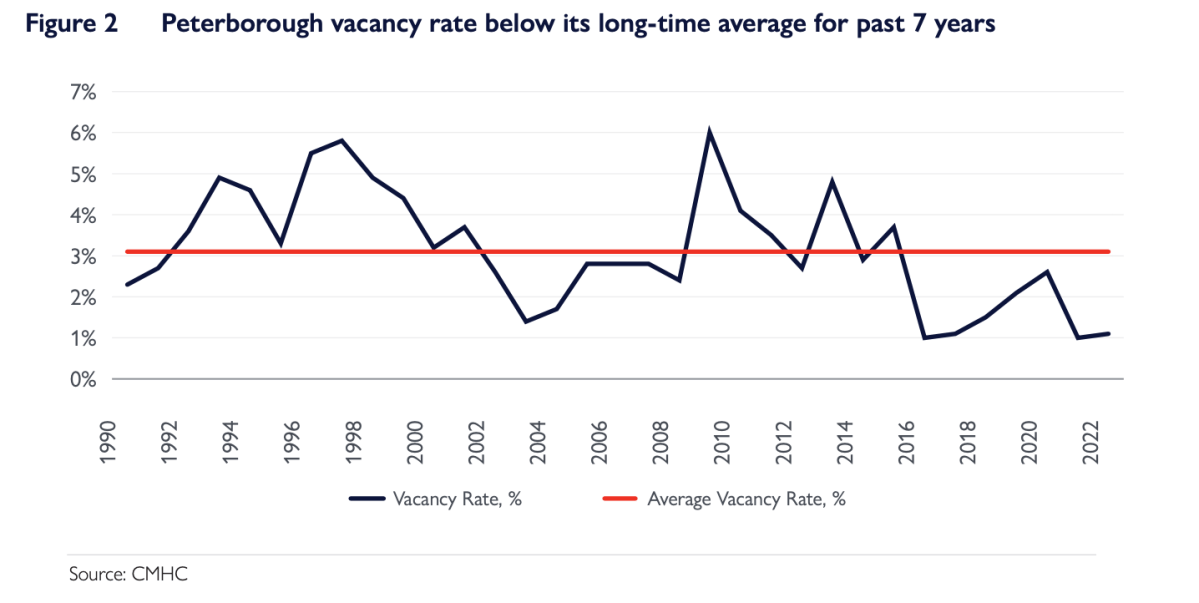For the second year in a row, the Peterborough area had the lowest apartment vacancy rate in Ontario, according to a report from the Canada Mortgage and Housing Corporation (CMHC) released on Thursday.

The Peterborough census metropolitan area’s (CMA) vacancy rate for purpose-built rental apartments was 1.1 per cent in October 2022, virtually unchanged from one per cent reported in 2021, states the CMHC’s Rental Market Report, which examines vacancy rates across the largest cities in Canada.
Ontario’s average was 1.8 per cent. Trailing the Peterborough CMA were Kingston and Kitchener-Cambridge-Waterloo, each at 1.2 per cent vacancy rates, and Guelph and Brantford, rounding out the top five at 1.5 per cent each.
The national vacancy rate was down from 3.1 per cent to 1.9 per cent in 2022 — the lowest level since 2001.
The Peterborough CMA 1.1 per cent vacancy rate echoes data in 2016-2017 which marked the lowest level in 30 years.
“Five years later in 2021 and 2022, it returned to its lowest level, suggest a persistent supply-to-demand challenge,” the report states of the Peterborough data. “All in all, the vacancy rate has remained below its long-run average of 3.1 per cent over the past seven years.”
“The vacancy rate stabilized because rental demand kept pace with supply growth in 2022,” the report states.
Rent
The CMHC study also shows an average two-bedroom apartment in Peterborough in 2022 was $1,339 — up 5.4 per cent from data in 2021.
The national average for a two-bedroom apartment is $1,258 — up 5.6 per cent from 2021.

Get breaking National news
The report states Peterborough’s rent rate was “heavily” impacted by longer-term tenancies as the region had one of the lowest turnover rates among Ontario CMAs at 9.7 per cent, just behind Oshawa at 9.5. per cent.
In 2022 the rent of vacant apartment units was 19 per higher than the rent of occupied units.
“The rent for two-bedroom apartments that turnover to new tenants increased by 23 per cent, on average,” the report states.
The study says demand for rentals increased thanks to a number of factors, including improved economic and demographic conditions for renters, such as employment recovery, and “renewed student inflows” with students returning to classes at Trent University and Fleming College.
“This year’s enrolment likely included more international students,” the report notes. “Data from Immigration Refugees and Citizenship Canada (IRCC) shows that there were 20 per cent more temporary residents living in Ontario on a study permit at the time of CMHC’s survey compared to the year before.”
The Peterborough area rent hike came as there was a 2.8 per cent increase in rental supply throughout the region — mainly from downtown Peterborough (Zone 1) which saw 170 more units in 2022.
Meanwhile, Zone 2 — which includes the remainder of the city, surrounding townships (Douro-Dummer, Cavan-Monaghan and Otonabee-South Monaghan), Curve Lake First Nation and Hiawatha First Nation — saw an increase from the return of units that were temporarily removed, not newly created ones.
Olga Golozub, senior analyst for economics, notes that despite a strong increase in rental supply, the market remained tight in both submarkets.
“Tight rental market conditions persisted in 2022 despite the 15-year high increase in rental supply,” she said.
Even with the 2.8 per cent rental supply increase, 160 more units were occupied in October 2022 compared with the year prior. Zone 1 had a 4.3 per cent increase in the number of occupied units — the highest level in a decade.
The report notes that increased competition resulted in no vacancies in rental buildings completed after 2005 in the Peterborough area — and that vacant units are being taken by tenants willing to relocate from larger cities, such as those able to work from home.
“Newer structures with modern amenities were more attractive to tenants, even though rents in such structures were the highest,” the report notes.











Comments